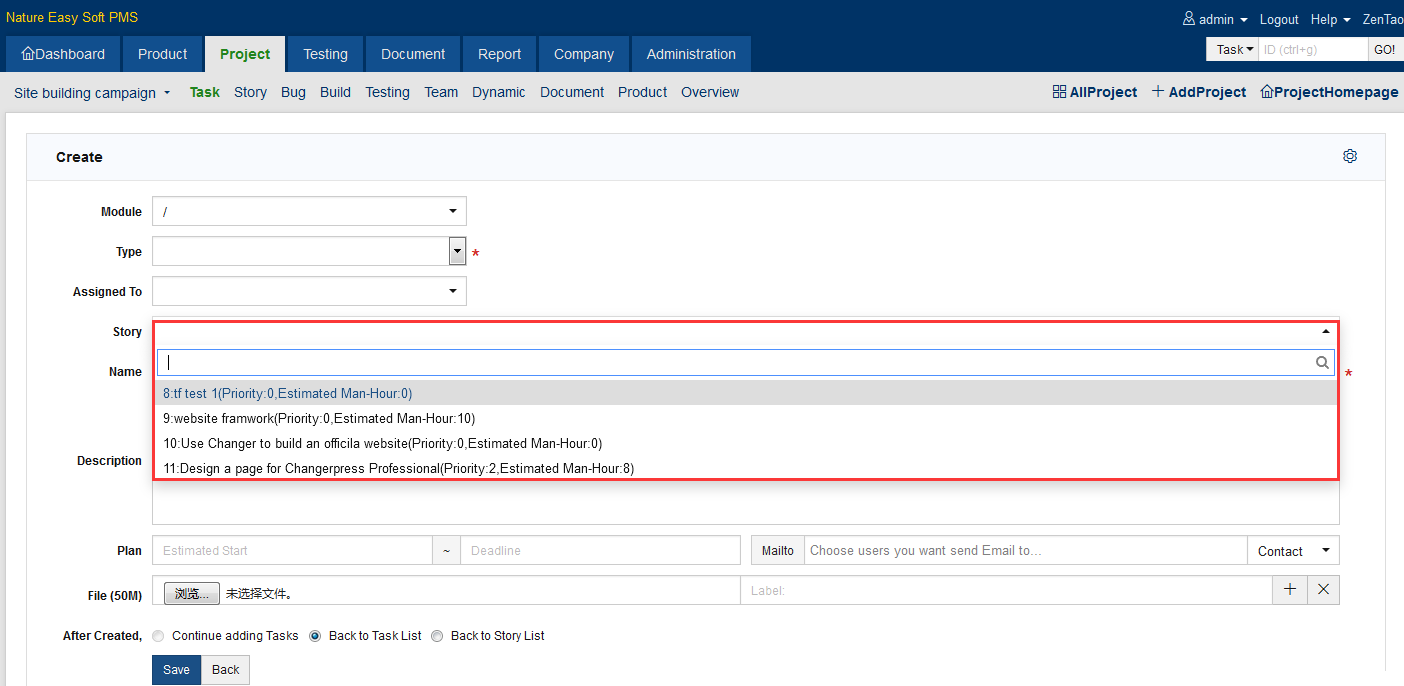- 1 Introduction
- 1.1 About ZenTao
- 1.2 How to get support
- 2 How to Install ZenTao
- 2.1 Choose the best installation
- 2.2 ZenTao Cloud
- 2.3 One-click Installation Package for Windows (Recommended)
- 2.4 One-click Installation Package for Linux
- 2.5 Source Code Installation Package (for all Systems)
- 2.6 Set up Virtualbox for ZenTao
- 2.7 Softaculous service
- 3 Upgrade ZenTao
- 3.1 Choose Upgrade
- 3.2 Upgrade by source codes (General for all systems)
- 3.3 Upgrade for one-click installation package for windows users (xampp)
- 3.4 Upgrade for one-click installation package for Linux
- 4 Users and Groups
- 5 Simple Application
- 6 Basic Application
- 6.1 Basic Workflow
- 6.2 Agile and Scrum
- 6.3 ZenTao and Scrum
- 6.4 ZenTao Tutorial for Rookies
- 6.5 Create a Product
- 6.6 Create a Story
- 6.7 Create a Project
- 6.8 Confirm Stories
- 6.9 Decompose Tasks
- 6.10 Report a Bug
- 6.11 Manage Contacts
- 6.12 Customization
- 7 Advanced Application
- 7.1 Workflow
- 7.1.1 ZenTao Workflow
- 7.2 Personal management
- 7.2.1 My To-dos
- 7.2.2 My Task, Story and Bug
- 7.2.3 My Profile
- 7.3 Product Manager
- 7.3.1 Manage a Product
- 7.3.2 Create and Review a Story
- 7.3.3 Change and Review a Story
- 7.3.4 Story Status
- 7.3.5 Notes for Writing a Story
- 7.3.6 Product Module
- 7.3.7 Release Plan
- 7.3.8 Create a Release
- 7.3.9 Roadmap
- 7.3.10 Manage Documents
- 7.3.11 Product Meetings
- 7.3.12 Project Management, Presentation and Summary
- 7.3.13 Story Reports
- 7.4 Project Manager
- 7.5 Development Team
- 7.5.1 Project planning meeting and decompose tasks
- 7.5.2 Claim and update Tasks
- 7.5.3 Create a Build
- 7.5.4 Test Task
- 7.5.5 Resolve a Bug
- 7.5.6 Manage Documents
- 7.5.7 Confirm Bugs
- 7.6 Testing Team
- 7.6.1 Bug Management
- 7.6.2 Submit a Bug
- 7.6.3 Confim and Close a Bug
- 7.6.4 Activate a Bug
- 7.6.5 Find a Bug
- 7.6.6 Test Case
- 7.6.7 Create a Test Case
- 7.6.8 Manage a Test Task
- 7.6.9 Execute Cases and Report Bugs
- 7.6.10 Reports
- 8 Configuration
- 8.1 Maintain ZenTao
- 8.1.1 Initialize scripts
- 8.1.2 Back up ZenTao
- 8.1.3 Recover the deleted
- 8.1.4 Update Burndown charts
- 8.2 Deploy ZenTao
- 8.2.1 Guest Login
- 8.2.2 Cnfigure Email
- 8.2.3 Set Super Admin
- 8.2.4 Configure Static Access
- 8.2.5 Delete "zentao" from your address
- 8.2.6 Integrate ZenTao with SVN
- 8.2.7 Integrate ZenTao with Git
- 9 Custom Development
- 9.1 ZenTao Mechanism of Developing
- 9.2 ZenTao Directory
- 9.3 Modify files
- 9.4 ZenTao Database
- 9.5 Common Modules
- 9.6 Add features to navigation bar
- 9.7 Examples: Modify Language Prompt
- 9.8 Examples: set priority when creating bugs
- 9.9 Web Editor
- 9.10 Packaging Standards of ZenTao 1.1
- 10 Other Relevant Issues
- 10.1 About third-party code
- 10.2 ZenTao FAQ
- 10.3 How to Help ZenTao
- 10.4 ZenTao Business Service
- 10.5 Acknowledgement
Decompose Tasks
- 2015-09-10 16:24:32
- azalea
- 11156
- Last edited by xiying guan on 2018-12-06 10:09:00
After creating the stories, all the key factors in a project have been touched, including lifecycle, resources and stories. Now what you have to do is to do WBS (
Work Breakdown Structure) for each story and generate all the tasks required to finish this story.
Notes: It is to finish all the tasks of the story, including but are not limited to design, development and test tasks.
1. Stories of a Project
2. Task Decomposition
3. Notes
3.1 All the stories should be decomposed into tasks, including design, test, design, even machine procurement and test environment deployment.
3.2 The decomposition should be as small as possible. For example, a task can be finished within several man hours.
3.3 If a task need several people to finish, then it should be further decomposed.
3.4 You can batch assign tasks, if the type of tasks are routine work. For example, a routine work is to ask every team member to write a project summary. In this case, you can select the type as routine workd and then assign it to all team members.
3.5 The type of tasks should be set carefully, since it will affect automatic calculations in development stories. We will explain this later.
3.6 The tasks are best to be claimed voluntarily, since this will boost people’s enthusiasm to the utmost extent.
Notes: It is to finish all the tasks of the story, including but are not limited to design, development and test tasks.
1. Stories of a Project
On the page of Stories, you can do decompositions of a story.
You can also check the number of tasks decomposed.

2. Task Decomposition
Now you can choose stories when creating taskd.
The link to related story can also be provided.

3. Notes
3.1 All the stories should be decomposed into tasks, including design, test, design, even machine procurement and test environment deployment.3.2 The decomposition should be as small as possible. For example, a task can be finished within several man hours.
3.3 If a task need several people to finish, then it should be further decomposed.
3.4 You can batch assign tasks, if the type of tasks are routine work. For example, a routine work is to ask every team member to write a project summary. In this case, you can select the type as routine workd and then assign it to all team members.
3.5 The type of tasks should be set carefully, since it will affect automatic calculations in development stories. We will explain this later.
3.6 The tasks are best to be claimed voluntarily, since this will boost people’s enthusiasm to the utmost extent.
Write a Comment
